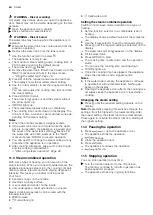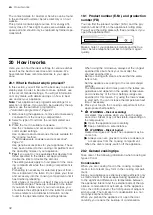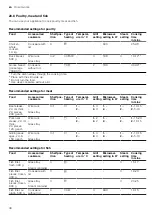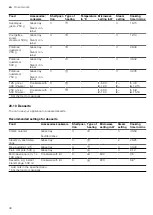
en
How it works
32
The contact details for Customer Service can be found
in the enclosed Customer Service directory or on our
website.
This product contains light sources from energy effi-
ciency class D. These light sources are available as a
spare part and should only be replaced by trained spe-
cialist staff.
19.1 Product number (E-Nr.) and production
number (FD)
You can find the product number (E-Nr.) and the pro-
duction number (FD) on the appliance's rating plate.
You will see the rating plate with these numbers if you
open the appliance door.
Make a note of your appliance's details and the Cus-
tomer Service telephone number to find them again
quickly.
20 How it works
Here, you can find the ideal settings for various dishes
as well as the best accessories and cookware. We
have tailored these recommendations to your appli-
ance.
20.1 What is the best way to proceed?
In this section, you will find out the best way to proceed
step-by-step in order to be able to make optimum use
of the recommended settings. You will get information
on many meals, with details and tips on how to best
use and set your appliance.
Note:
Your appliance has programmed settings for a
selection of dishes. If you want to be guided by the ap-
pliance, use the automatic programmes.
→
"Automatic programmes", Page 21
1.
Before using the appliance, remove all unnecessary
cookware from the cooking compartment.
2.
Select a type of food from the recommended set-
tings.
3.
Place the food in suitable cookware.
Use the cookware and accessories listed in the re-
commended settings.
Use cookware and accessories that are suitable for
the cooking method.
→
"Microwave-safe cookware and accessories",
Use genuine accessories for your appliance. These
have been tailored to the cooking compartment and
the operating modes of your appliance.
4. Tip:
If you want to cook quantities that deviate from
those specified in the tables, set approximately
double the time for double the amount.
The setting values apply to food placed in the cook-
ing compartment while the cooking compartment is
still cold.
Preheating is necessary for selected types of food –
this is indicated in the table. Do not place your food
and accessory into the cooking compartment until it
has finished preheating.
Some types of food turn out best if they are cooked
in multiple stages. These are indicated in the table.
If you wish to follow one of your own recipes, you
should use the settings listed in the table for similar
food as reference. Additional information can be
found in the tips listed after the settings tables.
When using the microwave, always set the longest
specified time but check your meal after the
shortest specified time.
Before cooking with steam, ensure that the water
tank is full.
Set the appliance according to the recommended
settings.
The temperatures and times given in the tables are
guidelines and depend on the quality, temperature
and consistency of the food. Settings ranges are
specified for this reason. Try using the lower values
to start with. You can increase the temperature next
time if necessary.
5.
Place your food in the cooking compartment in the
appropriate shelf position.
6.
WARNING ‒ Risk of scalding!
Hot steam may escape when you open the appli-
ance door. Steam may not be visible, depending on
the temperature.
▶
Open the appliance door carefully.
▶
Keep children at a safe distance.
WARNING ‒ Risk of burns!
Heated food gives off heat. The cookware may be-
come hot.
▶
Always use oven gloves to remove cookware or
accessories from the cooking compartment.
When the dish is ready, switch off the appliance.
20.2 General cooking tips
Take note of the following information when cooking all
types of food.
Condensation
When you are cooking food in the cooking compart-
ment, a lot of steam may form in the cooking compart-
ment.
Since your appliance is extremely energy-efficient, only
a small amount of heat escapes during operation. Due
to the significant differences in temperature between
the appliance interior and the external parts of the ap-
pliance, condensation may build up on the appliance
door, the control panel or the front panels of adjacent
kitchen units. The formation of condensation is a nor-
mal physical phenomenon.
When you preheat the appliance or open the door
carefully, you reduce the build-up of condensation.
















































